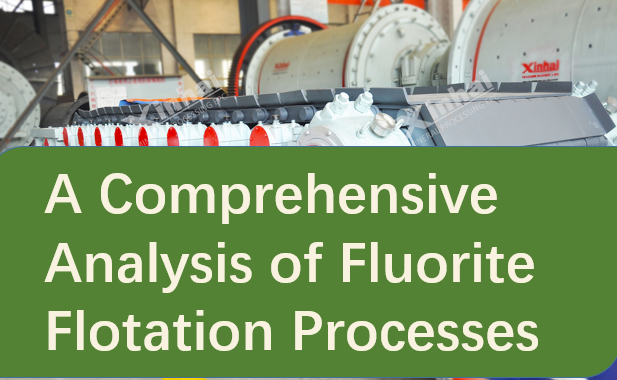A Comprehensive Analysis of Fluorite Flotation Processes
2025-06-05 Xinhai (1126)
2025-06-05 Xinhai (1126)
If you have any questions, please contact us through the following ways, we will give you more and better assistance!

Fluorite, also known as fluorspar, is primarily composed of calcium fluoride (CaF₂), a mineral that is relatively common in nature and has a wide range of applications. Due to its frequent association with various other minerals, fluorite ore can be classified into different types based on the characteristics of the gangue minerals, including quartz-type, sulphide-type, barite-type, and carbonate-type. Different types of fluorite ore require distinct mineral processing techniques.
Quartz-type fluorite ore primarily consists of fluorite and quartz, with fluorite content reaching 80%–90%, along with small amounts of calcite, barite, and sulphides. Due to the physical property differences between quartz and fluorite, flotation is the commonly used method for separating the two.
In production, a common process flow involves primary grinding and roughing, followed by regrinding of the rough concentrate and multiple stages of concentrating. Sodium carbonate is used as a pH adjuster to maintain the slurry pH at 8–9, preventing polyvalent cations in the water from activating quartz. When using fatty acids as collectors, an appropriate amount of water glass is added as a quartz inhibitor. However, the dosage of water glass must be strictly controlled, as small amounts of water glass can activate fluorite, while excessive amounts can inhibit fluorite flotation. Based on the distribution characteristics of the useful minerals, if the minerals are coarsely distributed, fatty acid-based collectors are commonly used in conjunction with sodium carbonate and water glass, and a single roughing followed by multiple concentrating processes can yield high-quality fluorite concentrate. If the minerals are finely distributed, the flotation reagents are the same as for coarse-grained deposits, but grinding must be intensified, and a staged grinding and staged separation process must be adopted to improve the liberation of the target minerals.

In sulphide-type fluorite ore, sulphides coexist with fluorite, and the ore composition is complex, making beneficiation challenging. Currently, flotation is the primary beneficiation technique.
During beneficiation, xanthate-type collectors are typically used to prioritize the flotation of sulfide minerals, with fluorite treated as flotation tailings for subsequent separate processing. For fluorite flotation, fatty acid-type reagents must be added, and multiple stages of concentration are required. Sometimes, to ensure the quality of the fluorite concentrate, a small amount of sulfide inhibitor, such as cyanide, is added during fluorite flotation to suppress residual sulfides. Additionally, roasting and leaching techniques can be used to extract valuable metals and decompose fluorite. These methods have relatively simple process flows and can simultaneously achieve comprehensive recovery of valuable metals while producing high-quality fluorite products.
Barite-type fluorite ore primarily consists of barite and fluorite, with barite content typically ranging from 10% to 40%, often accompanied by sulphide minerals such as pyrite, galena, and sphalerite. Due to the similar properties of barite and fluorite, their separation poses significant challenges.
Mining typically begins with mixed flotation to obtain a barite-fluorite mixed concentrate, followed by separation of barite and fluorite. Based on the order in which barite and fluorite float, there are two approaches: first, suppressing barite flotation to float fluorite, which yields high-grade barite concentrate and fluorite concentrate; second, suppressing fluorite flotation to float barite, first obtaining a barite concentrate, then adding fatty acid-based collectors and sodium silicate to the tailings, and undergoing multiple selective flotation processes to obtain a fluorite concentrate. This process is simple and easy to operate, but the fluorite grade is often not very high. In actual production, the process of flotating fluorite while suppressing barite is commonly adopted. Fatty acid-based flotation reagents are used as fluorite collectors, while organic suppressants such as caustic starch and dextrin are employed in combination with inorganic suppressants like sodium hexametaphosphate, sodium fluorosilicate, water glass, aluminium salts, and iron salts to achieve effective separation of fluorite and barite.
In carbonate-type fluorite ore, fluorite and calcite, among other carbonate minerals, have high content, and their chemical properties are similar, making flotation separation challenging.
When using general fatty acids as collectors, it is typically necessary to subject the slurry to high-temperature conditioning (50–60°C) and add calcium inhibitors; however, this increases construction costs, land requirements, and production costs. If oxide collectors and NaF are used together, good flotation selectivity can be achieved at an operating temperature of 23–25°C; if fatty acids are used as collectors and a dispersant (OTCMA) is added, high-grade flotation products can be produced at around 12°C. In terms of inhibitor selection, common options include water glass, sodium metaphosphate, lignin sulfonate, dextrin, tannic acid, and oxalic acid. To enhance inhibition effectiveness, these are often added to the flotation slurry in combination formulations to achieve separation of fluorite from carbonate minerals and obtain high-grade fluorite concentrate.